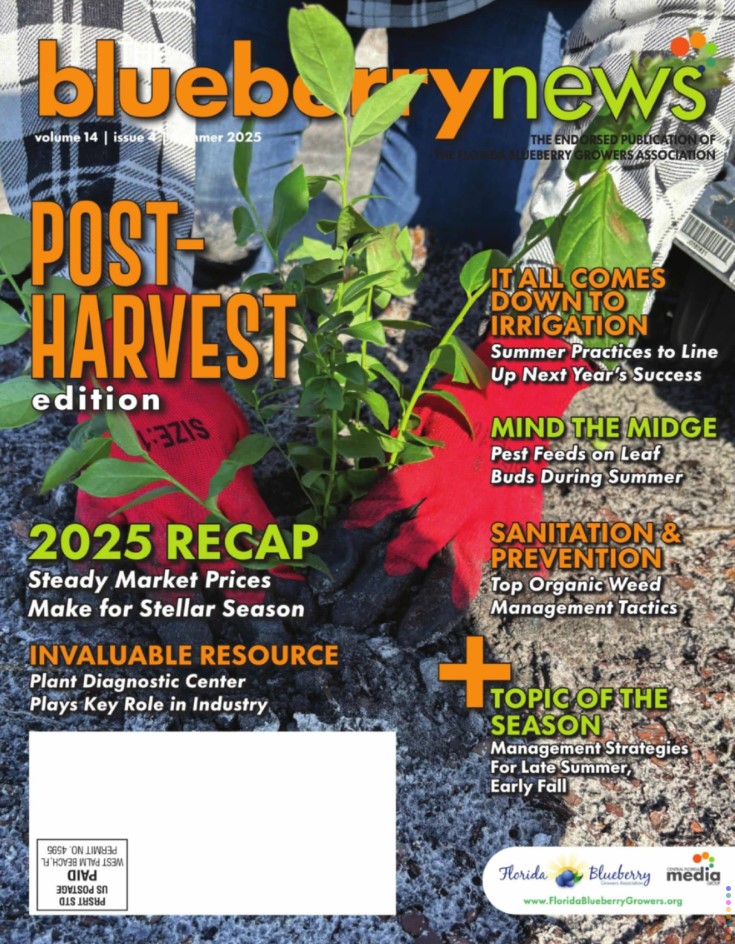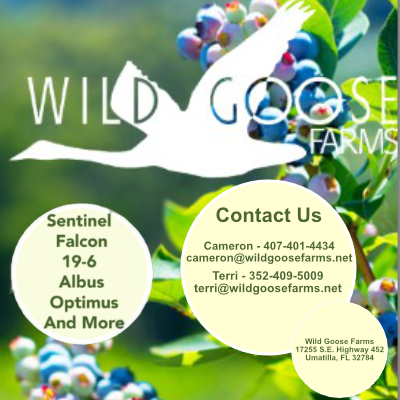Tackling the Challenges of Bark inclusions, Girdling Roots, Plant Collars and Stem Blight
The southern highbush blueberry growth habit is a multi-stem bush with cultivated varieties ranging from upright to spreading. The upright varieties like Meadowlark and Farthing tend to have narrower crowns, which lend themselves to more efficient machine harvesting possibilities. Most harvesting machines rely on movable catch plates that conform to the crown as the harvester passes down the row, with wider crowns allowing a larger gap and more fruit escaping the harvester to be lost to the ground. Upright varieties have become popular with growers for this reason and as labor costs continue to increase and labor availability continues to be challenging, to say the least.
The desire for machine harvestable varieties has been noted by breeding programs and has become one important trait considered by the UF/IFAS Breeding Program as new selections are considered for eventual release. Horticulturally, single-stem architecture has also been pursued through the grafting of southern highbush blueberry scions onto sparkleberry (Vaccinium arboreum) root stocks. More and more evidence seems to be mounting that this option, while adding substantial costs at establishment, may provide machine harvesting advantages, as well as plant longevity and soil adaptation characters to offset and bring good returns on that investment. Root stock accessions are being evaluated by UF but will require a few more years before large-scale evaluation and eventual industry-wide acceptance are realized.
Innovative growers have also devised methods to help train blueberry plants to be more upright with a narrower crown, using orange juice cartons or plastic sleeves (Figure 1). The cartons are placed over the rooted cuttings when they are planted in the field. As the plants are forced to grow up and out of the carton, canes are restricted and compact for the first 12 to 18 inches of height before expanding out into a canopy. Cartons represent a small per-plant cost that several growers have adopted over the past decade or so. Cardboard cartons eventually weather and break down while plastic sleeves tend to be more durable, restricting crown growth through and past the first growing season. For the most part, this practice has had the desired effect with minimal negative side effects.
Recently, however, a trend in samples submitted to the UF/IFAS Plant Diagnostic Center has emerged that warrants additional observation and research: samples exhibiting cane dieback, a loss of vigor, and plant death. The number of samples has been in the dozens, not thousands, but it warrants a closer look at the practice to investigate and ask why.
Figure 1. Plastic sleeve on young blueberry plant
Credits: D. Phillips, UF/IFAS
Dieback of collared plants is almost always associated with stem blight disease and/or insect feeding damage. Stem blight has been a continuous problem for the industry since the beginning. The disease is caused by one of a handful of fungi in the Botryosphaeriaceae family of related pathogens, and the incidence (number of plants affected in a planting) and the severity (how much dieback occurs when it’s observed) are greatly impacted by plant stress levels. Stem blight has fallen out of the top of most growers’ disease research priority lists largely because careful irrigation management and a movement away from varieties that over fruit and under leaf has limited losses compared to 15 years ago. More recent stem blight outbreaks have coincided with root diseases like bacterial wilt and phytophthora root rot, as well as flooding and stress associated with severe weather events (i.e., wind and excessive rain from tropical systems). When plants are affected by these, they become more susceptible to stem blight.
Recent research conducted at the University of Georgia in collaboration with UF (published 2022) looked at upright varieties and their propensity to form bark inclusions. Bark inclusions occur when crowded canes grow together encasing and compressing bark within the crown wood (Figure 2). As the crowns continue to expand, constrictions form in some plants’ vasculature, essentially pinching-off the supply of water to the upper plant parts while also limiting photosynthates (sugars) moving into the root zone to fuel healthy growth. Drought stress and root death can lead to dieback and increased susceptibility to stem blight disease. Bark inclusions and girdling roots can also weaken the architecture of the plant such that cane breakage more easily occurs. Broken canes both reduce the fruiting wood, and also open the plant to infection by the stem blight pathogens.
Figure 2. Bark inclusions on blueberry
Credit: P. Harmon, UF/IFAS
The UGA study measured the total lengths of bark inclusions as well as stem blight incidence and the force required to break branches from plants. Bark inclusion lengths correlated to stem blight, with higher inclusion measurements corresponding to greater stem blight severity (Figure 3). Breakage force required to split a plant or break a cane from the crown was reduced as bark inclusion length increased. These results showed that individual plants of varieties that tend to have a compact crown develop more stem blight and are more likely to suffer breakage (as observed during tropical wind events) as the number and lengths of bark inclusions increase.
Figure 3. Stem blight and bark inclusions on blueberry
Credits: P. Harmon, UF/IFAS
These results are somewhat concerning since cartons and plastic sleeves are used to further constrict the crowns of blueberry plants—resulting in increased bark inclusion lengths. The benefits of this practice certainly outweigh the negative effects, or growers wouldn’t employ them; however, stem blight is not a foe to turn your back on. Keep an eye on those cartons and plastic sleeves as plants age and please reach out to the UF/IFAS Blueberry Team with comments or questions.
CREDITS:
PHIL HARMON, professor of plant pathology, UF
& DOUG PHILLIPS, Blueberry Extension Coordinator
Reference:
Holland, Peterson, Harmon, Brannen and Scherm. Horticulturae 2022, 8, 733. https://doi.org/10.3390/horticulturae8080733





